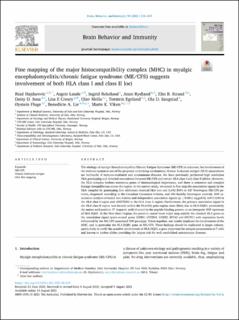Fine mapping of the major histocompatibility complex (MHC) in myalgic encephalomyelitis/chronic fatigue syndrome (ME/CFS) suggests involvement of both HLA class I and class II loci
Hajdarevic, Riad; Lande, Asgeir; Rekeland, Ingrid Gurvin; Rydland, Anne; Strand, Elin B.; Sosa, Daysi Duarte; Creary, Lisa E; Mella, Olav; Egeland, Torstein; Saugstad, Ola Didrik; Fluge, Øystein; Lie, Benedicte Alexandra; Viken, Marte Kathrine
Journal article, Peer reviewed
Published version

Åpne
Permanent lenke
https://hdl.handle.net/11250/2774628Utgivelsesdato
2021Metadata
Vis full innførselSamlinger
- Department of Clinical Science [2318]
- Registrations from Cristin [9791]
Sammendrag
The etiology of myalgic Encephalomyelitis/Chronic Fatigue Syndrome (ME/CFS) is unknown, but involvement of the immune system is one of the proposed underlying mechanisms. Human leukocyte antigen (HLA) associations are hallmarks of immune-mediated and autoimmune diseases. We have previously performed high resolution HLA genotyping and detected associations between ME/CFS and certain HLA class I and class II alleles. However, the HLA complex harbors numerous genes of immunological importance, and there is extensive and complex linkage disequilibrium across the region. In the current study, we aimed to fine map the association signals in the HLA complex by genotyping five additional classical HLA loci and 5,342 SNPs in 427 Norwegian ME/CFS patients, diagnosed according to the Canadian Consensus Criteria, and 480 healthy Norwegian controls. SNP association analysis revealed two distinct and independent association signals (p ≤ 0.001) tagged by rs4711249 in the HLA class I region and rs9275582 in the HLA class II region. Furthermore, the primary association signal in the HLA class II region was located within the HLA-DQ gene region, most likely due to HLA-DQB1, particularly the amino acid position 57 (aspartic acid/alanine) in the peptide binding groove, or an intergenic SNP upstream of HLA-DQB1. In the HLA class I region, the putative causal locus might map outside the classical HLA genes as the association signal spans several genes (DDR1, GTF2H4, VARS2, SFTA2 and DPCR1) with expression levels influenced by the ME/CFS associated SNP genotype. Taken together, our results implicate the involvement of the MHC, and in particular the HLA-DQB1 gene, in ME/CFS. These findings should be replicated in larger cohorts, particularly to verify the putative involvement of HLA-DQB1, a gene important for antigen-presentation to T cells and known to harbor alleles providing the largest risk for well–established autoimmune diseases.
